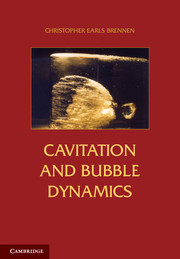5 - Translation of Bubbles
Published online by Cambridge University Press: 05 October 2013
Summary
Introduction
This chapter will briefly review the issues and problems involved in constructing the equations of motion for individual bubbles (or drops or solid particles) moving through a fluid and will therefore focus on the dynamics of relative motion rather than the dynamics of growth and collapse. For convenience we shall use the generic name “particle” when any or all of bubbles, drops, and solid particles are being considered. The analyses are implicitly confined to those circumstances in which the interactions between neighboring particles are negligible. In very dilute multiphase flows in which the particles are very small compared with the global dimensions of the flow and are very far apart compared with the particle size, it is often sufficient to solve for the velocity and pressure, ui(xi, t) and p(xi, t), of the continuous suspending fluid while ignoring the particles or disperse phase. Given this solution one could then solve an equation of motion for the particle to determine its trajectory. This chapter will focus on the construction of such a particle or bubble equation of motion. Interactions between particles or, more particularly, bubble, are left for later.
The body of fluid mechanical literature on the subject of flows around particles or bodies is very large indeed. Here we present a summary that focuses on a spherical particle of radius, R, and employs the following common notation. The components of the translational velocity of the center of the particle will be denoted by Vi(t).
- Type
- Chapter
- Information
- Cavitation and Bubble Dynamics , pp. 110 - 144Publisher: Cambridge University PressPrint publication year: 2013



